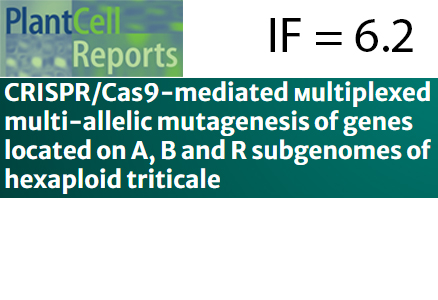Press-room / Digest

CRISPR/Cas9-mediated мultiplexed multi-allelic mutagenesis of genes located on A, B and R subgenomes of hexaploid triticale
This research, performed by the members of the Laboratory of Expression Systems and Plant Genome Modification (BIOTRON), Department of Plant Molecular Biology and Biotechnology, together with colleagues from the All-Russia Research Institute of Agricultural Biotechnology, reports the first time production of edited hexaploid triticale (× Triticosecale) through CRISPR/Cas9-mediated multiplexed induction of multilocular mutations in genes associated with starch biosynthesis. The results are published in Plant Cell Reports. Learn more

Obtaining Gene-Modified HLA-E-Expressing Feeder Cells for Stimulation of Natural Killer Cells
In response to cytomegalovirus (HCMV) infection, a pool of specialized “adaptive” NK cells with immunological memory traits develops in humans. This process is based on the recognition of HCMV peptides presented in the context of the HLA-E molecule by the activating receptor NKG2C. Using retroviral transduction, members of the Laboratory of Cell Interactions of the Immunology Department, IBCH RAS, together with colleagues from the European Medical Center, obtained K562-21E feeder cells expressing HLA-E and identified a subpopulation, whose size is associated with the magnitude of NK cell proliferative response to the presentation of the HCMV peptide. The K562-21E cells can be applied both for the accumulation of HCMV-specific NK cells and for studying the adaptive cells maturation. The results are published in Pharmaceutics.

Multiple paralogs of foxg1, the regulator of forebrain development, in lampreys and sturgeons: the legacy of genomic duplications in the early evolution of vertebrates
The foxg1 is known as one of the key regulators of the early development of the forebrain and related sensory organs. Employees of the Laboratory of Molecular Basis of Embryogenesis of the Institute of Bioorganic Chemistry, Russian Academy of Sciences, were the first to identify multiple foxg1 paralogs in lampreys and sturgeons, as archaic representatives of two branches of vertebrates - jawless and gnathostomes. A phylogenetic analysis of vertebrate Foxg1 proteins was carried out, and the expression patterns of foxg1 paralogues in river lamprey and sterlet were studied. The timing of duplication of foxg1 paralogues in the evolution of agnathans and gnathostomes was estimated. As a result, no reliable pairwise orthology of the foxg1 genes was identified in agnathans and gnathostomes. At the same time, it was shown that the phylogeny of foxg1 paralogs in sturgeons corresponds to the model of ancestral duplication followed by asynchronous rediploidization and indicates a genomic duplication that occurred at the level of the common ancestor of sturgeons. The results are published in Frontiers in Cell and Developmental Biology. Learn more

Hydrogen peroxide is not generated intracellularly in human neural spheroids during ischemia-reperfusion
Reactive oxygen species (ROS) are considered a primary source of damage during an ischemic stroke. Studies on this subject are usually performed on either cell culture or animal models, which can make it difficult to translate the results to humans. Currently, 3D neurospheroids derived from induced pluripotent stem cells (iPSCs) are proposed as an optimal alternative for modeling disease conditions. Researchers from the IBCh RAS and other Russian institutions report live imaging of hydrogen peroxide dynamics during the acute phase of hypoxia and reperfusion in human iPSC-derived neural spheroids, stably expressing fluorescent biosensor HyPer7. Contrary to expectations, they demonstrated the absence of ROS overproduction during the ischemia-reperfusion experiment. These results raise concerns about the applicability of such ischemia-reperfusion models due to the lack of a hallmark ROS signature of ischemic stroke. The results are published in Free Radical Biology and Medicine. Learn more

Age-dependent astrocytic atrophy and mitochondrial malfunction in human neocortex
Scientists from the IBCh RAS in collaboration with colleagues from other institutes have delved into the intricate cellular changes occurring in the brains of aging adults. The results of the study challenges existing paradigms by uncovering distinct responses to aging in astrocytes and neurons. Key findings include a significant decrease in the amount of reduced mitochondrial cytochromes in astrocytes, signaling potential mitochondrial dysfunction linked to aging. Notably, this phenomenon was not observed in neurons, highlighting cell-specific nuances in the aging process. The findings pave the way for a more nuanced understanding of the aging process, considering cell-type-specific responses within the brain active milieu. The results are published in Nature Communications. Learn more

